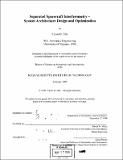Separated spacecraft interferometry : system architecture design and optimization
Author(s)
Jilla, Cyrus D., 1974-
DownloadFull printable version (25.21Mb)
Advisor
David W. Miller.
Terms of use
Metadata
Show full item recordAbstract
Through a process of system design, analysis, and optimization, the trade space for future optical separated spacecraft interferometers (SSI's) is explored. Using Distributed Satellite System principles, eleven separate architectures ranging in size from three to five spacecraft are compared on the basis of four metrics: 1) capability, 2) performance, 3) adaptability, and 4) cost per function. The independent SSI architecture variables include the total number of spacecraft, the type of spacecraft, the number of combiner payloads, and the number of collector payloads. Architecture variables held constant in this study, but which may be varied in future studies, include the array's geometric configuration, the maximum baseline, the mass and power requirements of each payload, the spacecraft propulsion system, the component failure rates, and the mission design life. Three models are developed and coupled to analyze each architecture. A capability model calculates the instantaneous u-v coverage, image quality, angular resolution, and imaging rate of each proposed architecture. The reliability model uses combinatorial analysis and Markov techniques to determine both the probability that the system will continue to function over a given amount of time and the likelihood with which the system will function in different partially failed states throughout the mission. The reliability model is then coupled with the capability model to calculate total performance over the mission lifetime. The cost model, which is divided into payload, spacecraft bus, launch, and operations costs, estimates the total lifecycle cost of each architecture. On the basis of the cost per synthesized image metric, two architectures were identified as providing the greatest value for the money. The design features in order of importance are imaging rate, total system cost, and total system reliability.
Description
Thesis (S.M.)--Massachusetts Institute of Technology, Dept. of Aeronautics and Astronautics, 1999. Includes bibliographical references (p. 123-126).
Date issued
1999Department
Massachusetts Institute of Technology. Department of Aeronautics and AstronauticsPublisher
Massachusetts Institute of Technology
Keywords
Aeronautics and Astronautics